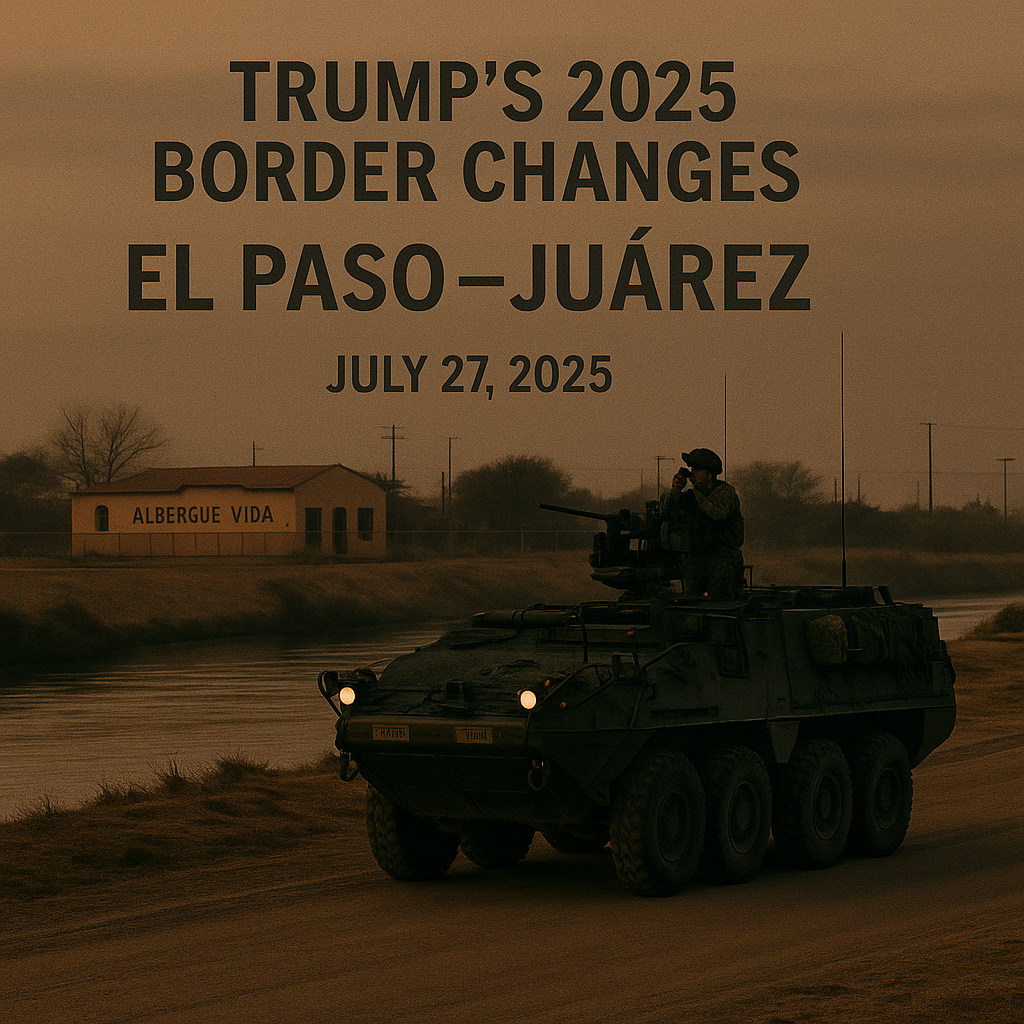Trump U.S.-Mexico Border Changes 2025: El Paso-Juárez Faces New Reality

The once-bustling El Paso–Juárez corridor, a historic gateway for migrants chasing the American dream, has fallen silent under President Trump’s sweeping 2025 border policies. On July 27, 2025, the Los Angeles Times reported a stark transformation: empty shelters, factory layoffs, and military zones replacing the vibrant flow of people and commerce. With a total asylum ban, mass deportation campaigns, and unprecedented militarization, Trump’s U.S.-Mexico border changes 2025 have reshaped life in this region. From stranded migrants to economic upheaval, what do these changes mean for El Paso, Juárez, and beyond? This article explores the policies, their impacts, and the uncertain future of this borderland.
Policy Changes and Implementation
Since taking office on January 20, 2025, President Trump has enacted a series of executive orders to overhaul U.S. immigration policy, particularly along the 2,000-mile U.S.-Mexico border:
- Asylum Ban: Trump’s “Securing Our Borders” order indefinitely suspended asylum access, canceling the CBP One app, which had facilitated nearly 1 million legal entries. Migrants with scheduled appointments, like 270,000 stranded in Mexico, were turned away, leaving shelters like Oasis del Migrante in Juárez nearly empty.
- Mass Deportations: The administration aims to deport millions, prioritizing those with criminal records but expanding to all undocumented immigrants. Over 48,000 were deported to Mexico by June 11, 2025, with military aircraft, like C-17s at Fort Bliss, El Paso, used for flights costing $4,675 per migrant—five times a commercial ticket.
- Militarization: The Pentagon deployed 9,000 active-duty troops, including 1,500 to El Paso and San Diego, designating 200-mile “national defense” zones in New Mexico and 63 miles in Texas. Stryker vehicles and U-2 spy planes patrol, while Fort Bliss constructs a 5,000-bed detention camp.
- Tariff Threats: Trump’s proposed 25% tariffs on Mexican goods, set for February 1, 2025, have led to factory layoffs in Juárez, with 308,000 workers employed compared to 340,000 previously, per INDEX Juárez.
- Remain in Mexico Revival: The reinstated Migrant Protection Protocols force non-Mexican asylum seekers to wait in Mexico, a policy criticized for exposing migrants to violence and facing legal challenges.
These measures, coupled with Mexico’s increased enforcement, including 10,000 National Guard troops and tunnel crackdowns, have reduced illegal crossings to historic lows—6,000 Border Patrol arrests in June 2025, down from 250,000 in December 2023.
Impact on El Paso–Juárez
The El Paso–Juárez corridor, once a migration hub, now faces profound changes:
- Migration Decline: Shelters like Albergue Vida in Juárez, which housed 1,400 migrants, now hold just 250. Volunteers like Juan Ortíz, who left water for migrants, report encountering no one, with crossings dropping to 137 daily across the border.
- Self-Deportations: Migrants like Maikold Zapata, a Venezuelan landscaper, and Richard Osorio, a home care worker, fled the U.S. fearing detention, tracked by ankle bracelets. Zapata abandoned his asylum claim, crossing back to Juárez, while Osorio hopes to reunite with his detained husband in Mexico.
- Economic Fallout: Juárez’s factories, vital under NAFTA, face layoffs due to tariff fears, with workers like Juan Bustos struggling to find jobs. In New Mexico, industrial projects in Santa Teresa stalled as companies withdrew.
- Community Strain: Pastor Francisco González Palacios, running Albergue Vida, urges migrants to seek work in Mexico, but funding cuts to U.S. Agency for International Development threaten shelter closures. Mexico’s “Mexico Embraces You” campaign builds tent shelters for deportees, yet only 6,200 Mexicans have been deported, per officials.
Reactions and Challenges
- Local Sentiment: Juárez residents, like worker Jorge Villarreal, express anxiety over Trump’s unpredictable policies, with life tied to Washington’s decisions. El Paso advocates, including the Diocese, condemn the end of “sensitive locations” protections, allowing ICE arrests at schools and churches.
- Mexican Response: President Claudia Sheinbaum remains diplomatic, preparing shelters and counter-tariffs while downplaying chaos. A tunnel discovery on January 9, 2025, shows Mexico’s efforts to curb smuggling, with 100 National Guard troops deployed to Juárez.
- Legal Battles: A federal court ruled Trump’s asylum ban unlawful on July 3, 2025, citing an invalid “invasion” claim, but deportations continue, with challenges pending. The use of the Alien Enemies Act and Insurrection Act risks legal and civil-military tensions.
- X Sentiment: Posts on X praise Trump’s policies, with @dogeai_gov claiming a 60% drop in crossings due to “Remain in Mexico” and surveillance tech, though experts warn of misinformation amplifying anti-immigrant narratives.
Broader Implications
- Humanitarian Crisis: Stranded migrants face danger in Mexico, with reports of kidnapping and extortion. A 2023 Juárez detention fire, killing 40, underscores enforcement risks.
- Economic Ripple Effects: Tariff threats could drive Mexico’s economy into recession, reducing remittances ($63 billion in 2024) and spurring more migration.
- Border Safety: Militarized policies push migrants to dangerous desert routes, with 299 remains found in El Paso’s sector from January 2023 to August 2024, per the Texas Tribune.
- Long-Term Migration: Activists like Ortíz argue migration, rooted in economic disparity and history, will persist despite barriers, with smugglers adapting to riskier routes.
Challenges Ahead
The administration faces logistical hurdles, with ICE’s 41,500 detention beds and limited aircraft insufficient for mass deportations. Legal challenges, like the asylum ban ruling, and Mexico’s strained capacity to absorb deportees complicate efforts. Juárez’s shelters, at 40% capacity, may overflow if deportations surge. Trump’s tariff threats, potentially effective February 1, 2025, risk trade wars, with Mexico and Canada preparing counter-tariffs. The border’s militarization, including Guantanamo Bay detentions, raises constitutional concerns, potentially politicizing the military.
Conclusion
The Trump U.S.-Mexico border changes 2025 have turned the El Paso–Juárez corridor into a shadow of its former self, with empty shelters, military patrols, and economic uncertainty. Policies like the asylum ban, deportations, and tariff threats have slashed crossings but left migrants stranded and local economies reeling. As legal battles loom and Mexico braces for deportees, the region’s future hinges on Trump’s next moves. Will migration rebound, or will the border remain sealed? Share your thoughts below and stay updated on this evolving story.










